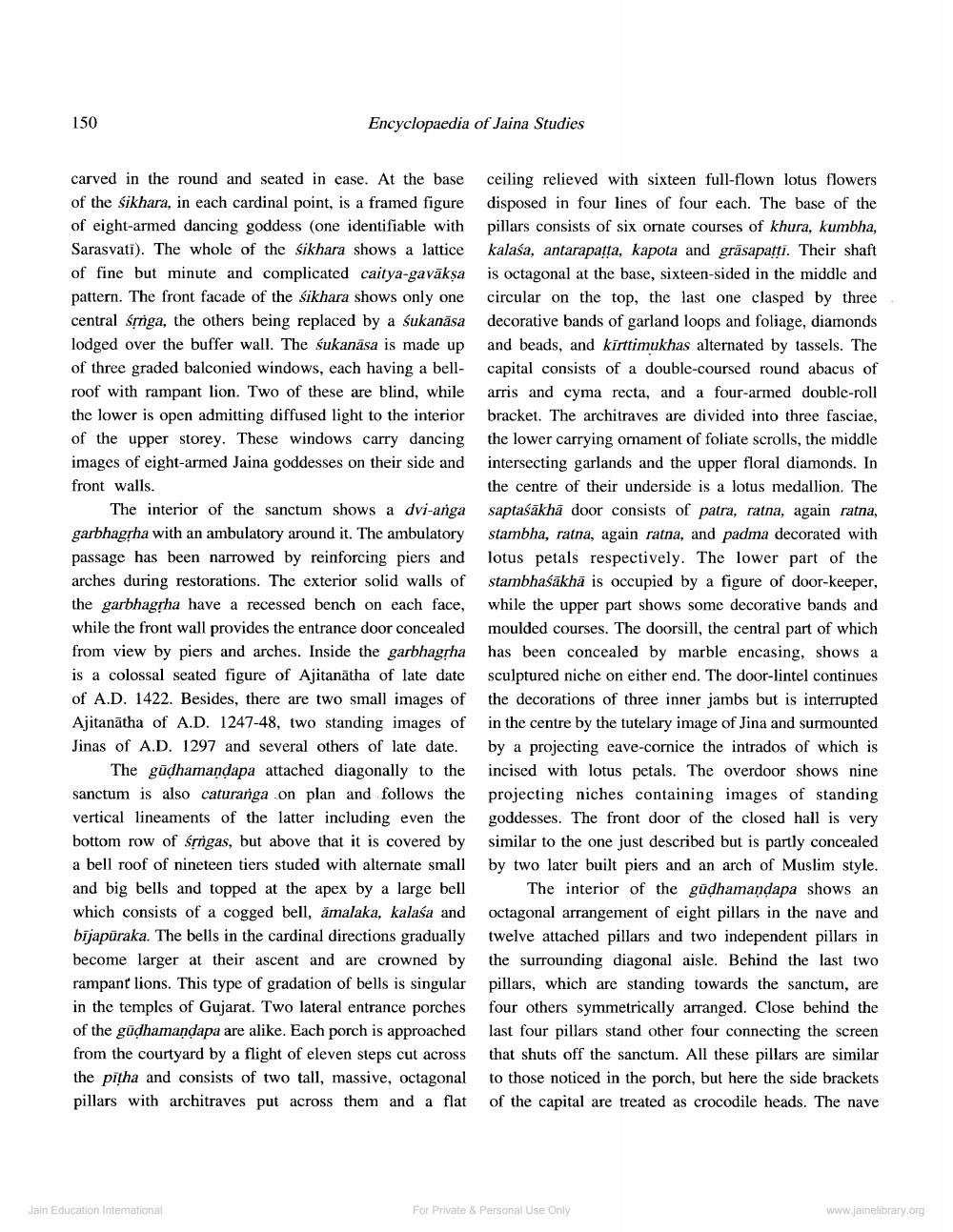________________
150
Encyclopaedia of Jaina Studies
carved in the round and seated in ease. At the base of the Sikhara, in each cardinal point, is a framed figure of eight-armed dancing goddess (one identifiable with Sarasvati). The whole of the Sikhara shows a lattice of fine but minute and complicated caitya-gavākṣa pattern. The front facade of the sikhara shows only one central śrriga, the others being replaced by a sukanāsa lodged over the buffer wall. The sukanāsa is made up of three graded balconied windows, each having a bell- roof with rampant lion. Two of these are blind, while the lower is open admitting diffused light to the interior of the upper storey. These windows carry dancing images of eight-armed Jaina goddesses on their side and front walls.
The interior of the sanctum shows a dvi-anga garbhagrha with an ambulatory around it. The ambulatory passage has been narrowed by reinforcing piers and arches during restorations. The exterior solid walls of the garbhagrha have a recessed bench on each face, while the front wall provides the entrance door concealed from view by piers and arches. Inside the garbhagsha is a colossal seated figure of Ajitanātha of late date of A.D. 1422. Besides, there are two small images of Ajitanātha of A.D. 1247-48, two standing images of Jinas of A.D. 1297 and several others of late date.
The gūdhamandapa attached diagonally to the sanctum is also caturanga on plan and follows the vertical lineaments of the latter including even the bottom row of śmigas, but above that it is covered by a bell roof of nineteen tiers studed with alternate small and big bells and topped at the apex by a large bell which consists of a cogged bell, amalaka, kalaśa and bijapuraka. The bells in the cardinal directions gradually become larger at their ascent and are crowned by rampant lions. This type of gradation of bells is singular in the temples of Gujarat. Two lateral entrance porches of the gūdhamandapa are alike. Each porch is approached from the courtyard by a flight of eleven steps cut across the pitha and consists of two tall, massive, octagonal pillars with architraves put across them and a flat
ceiling relieved with sixteen full-flown lotus flowers disposed in four lines of four each. The base of the pillars consists of six ornate courses of khura, kumbha, kalaša, antarapatta, kapota and gräsapatti. Their shaft is octagonal at the base, sixteen-sided in the middle and circular on the top, the last one clasped by three decorative bands of garland loops and foliage, diamonds and beads, and kīrttimukhas alternated by tassels. The capital consists of a double-coursed round abacus of arris and cyma recta, and a four-armed double-roll bracket. The architraves are divided into three fasciae, the lower carrying ornament of foliate scrolls, the middle intersecting garlands and the upper floral diamonds. In the centre of their underside is a lotus medallion. The saptaśākhā door consists of patra, ratna, again ratna, stambha, ratna, again ratna, and padma decorated with lotus petals respectively. The lower part of the stambhaśākhā is occupied by a figure of door-keeper, while the upper part shows some decorative bands and moulded courses. The doorsill, the central part of which has been concealed by marble encasing, shows a sculptured niche on either end. The door-lintel continues the decorations of three inner jambs but is interrupted in the centre by the tutelary image of Jina and surmounted by a projecting eave-cornice the intrados of which is incised with lotus petals. The overdoor shows nine projecting niches containing images of standing goddesses. The front door of the closed hall is very similar to the one just described but is partly concealed by two later built piers and an arch of Muslim style.
The interior of the güdhamandapa shows an octagonal arrangement of eight pillars in the nave and twelve attached pillars and two independent pillars in the surrounding diagonal aisle. Behind the last two pillars, which are standing towards the sanctum, are four others symmetrically arranged. Close behind the last four pillars stand other four connecting the screen that shuts off the sanctum. All these pillars are similar to those noticed in the porch, but here the side brackets of the capital are treated as crocodile heads. The nave
Jain Education Intemational
For Private & Personal Use Only
www.jainelibrary.org




